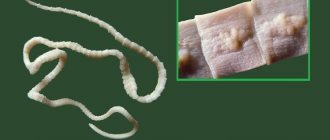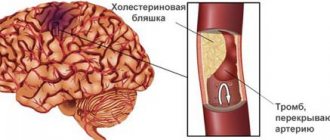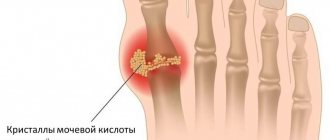Parasites
are organisms that use other living beings as a source of food or habitat, causing them harm. The word “parasite” is translated from Greek as parasite.
- Worms-Helminths
- Symptoms
- Diagnostics
- Treatment
- Our doctors
- Make an appointment
- Questions and answers
Parasites are very diverse. They can be microscopic or can reach several meters in length. Their habitats in the body are also different: intestines, liver, muscles, sometimes even the brain. In fact, parasites can live anywhere. If the parasite is worms (worms), the disease is usually called helminthiasis.
Uninvited “guests” of our body are dangerous for two reasons: they can both mechanically destroy organs and poison them with the products of their vital activity.
It is noteworthy that infection with parasites rarely leads to death. This is not surprising, because the parasite itself will die along with the host. Therefore, people can spend years being treated for a variety of ailments, attribute fatigue to a lack of vitamins, and allergies to poor ecology and heredity. But the cause of these problems may be a parasite that poisons the body. Not a single person in the world, regardless of his age and social status, can be protected from parasites entering his body.
Symptoms of helminth infection
Complaints from people who have parasites in their bodies can be very diverse. The following symptoms of helminth parasites are possible:
- indigestion, increased gas formation, unstable stools, frequent abdominal pain, itching in the anus;
- pain and inflammation in the joints;
- skin rashes, skin itching:
- weakness, fatigue, hair loss, low hemoglobin levels;
- mental depression, irritability, anxiety, grinding teeth and drooling during sleep, insomnia and other sleep disorders;
- feeling unwell for no apparent reason or diagnosis.
Increased sensitivity to allergens can also be the result of the activity of worms. It is believed that more than half of all allergic reactions and even cases of bronchial asthma may be the result of existing or previously experienced helminthiasis.
How to treat
Today, a parasitologist has over 10 anthelmintic drugs in his arsenal, which have their own specific activity against various types of worms.
The main drugs for the treatment of worms:
- Piperazine (10-30 rub.);
- Pyrantel - Helmintox (80-120 rub.);
- Pirantel (30-50 r);
- Nemocid, Combantrin Mebendazole - Vermox (90 rubles);
- Vermakar, Mebex, Vero-Mebendazole, Thermox, Vormin (20 rubles);
- Albendazole - Nemozol (120-150 rubles);
- Gelmodol-VM, Vormil Levamisole - Dekaris (70-90 rubles);
- Carbendacim - Medamin (70-90 rubles);
- Pyrvinium embonate - Pyrivinium, Pyrkon, Vanquin.
Types of parasites
There are a great many organisms that live off of us. Currently, more than 200 species of parasites have been identified in humans. Here are the most common ones.
Toxoplasma
Affects the nervous system, liver, spleen, skeletal muscles and myocardium. Most dangerous for pregnant women. If the expectant mother gets sick with toxoplasmosis, the child will most likely be born with deformities.
Amoeba
Most often it causes damage to the colon with prolonged diarrhea. According to WHO, 10% of the world's population suffers from amebiasis.
Alveococcus
Grows into the tissue of the host organ, like a malignant tumor. The liver and brain are often affected, where the size of the formation caused by the parasite can reach 15 cm in diameter.
Schistosoma
Lives and multiplies in the blood of a sick person. Can pass through the walls of blood vessels, entering the bladder and intestines. The embryos located inside the eggs secrete a specific poison that destroys tissue and poisons the body.
Pinworms
Most often found in children, they inhabit the lower parts of the small intestine and part of the large intestine. If pinworms clog the appendix, it can cause an attack of appendicitis. Digestion and absorption of food are disrupted, and the level of important microelements in the blood of patients is significantly reduced.
Roundworms
Ascaris larvae in the human body can lead to serious disruptions in the functioning of the immune system. At an early stage of the disease, there may be an increase in body temperature, a dry cough, a rash, and sometimes an enlarged liver. Having settled in the intestines, roundworms secrete poisons that are strong allergens.
Are worms transmitted from person to person?
With the strictest observance of all hygiene rules, it is impossible to protect yourself 100% from helminth infection. However, this reduces the risk of parasites entering the body by approximately 60%. Are parasites transmitted from person to person? Despite popular opinion, animals do not pose the greatest risk of becoming infected with helminths. The route of infection by parasites through contact between people is the most common, in addition, some types of worms are transmitted only this way.
The risk group includes preschool-aged children and children who go to primary school. This is explained by the still fragile immune system, the child’s daily presence in public places, the characteristics of the child’s body, and the common habit of biting nails. Parents should know how helminthiasis is transmitted - this will prevent infection of the baby.
Important diagnostics
Modern diagnostic methods make it possible to identify almost all types of parasites. However, cases of infection often remain unsolved. Usually patients do not even think that they could be attacked by worms. After all, weakness, depression, loss of appetite, headaches, allergic reactions can occur with a variety of diseases.
As a result, people are not given the necessary examination, and the true cause of the illness is not revealed. And the person continues to visit doctors and take useless medications.
Therefore, diagnosing parasitic infections is very important. Especially in cases where the diagnosis is not fully understood, treatment does not help the person well, and complaints remain.
Make an appointment
The clinic offers the services of an experienced gastroenterologist, candidate or doctor of medical sciences, who will make a preliminary diagnosis, prescribe only the necessary studies according to the results of the examination, and write out a treatment plan. Having our own laboratory allows us to quickly obtain tests, and the absence of queues and appointments by appointment allows us to prescribe treatment as soon as possible. To make an appointment, select the doctor you like and fill out the form on the website, use the general appointment form, the function to order a call back, or simply call our contact center.
Treatment of helminths - individually
INITIAL CONSULTATION
from RUB 2,350
There are no universal methods of getting rid of parasites. The approach to treatment is always individual. Treatment with medications or other methods is possible. Sometimes even surgery is required. The final tactics for getting rid of parasites are prescribed by the doctor after a thorough examination.
Currently, due to serious changes in the environment, the widespread use of antibiotics and other drugs, and often unhealthy diets, the clinical picture of helminthiasis has changed. According to ART data, every second or third child is diagnosed with parasitic problems: giardiasis, ascariasis, hookworm, toxoplasmosis, enterobiasis, etc. Due to the expanded borders for travel to exotic and warm countries, helminthiases are often detected, which were previously observed only in certain regions - schistosomiasis, opisthorchiasis, etc. The presence of helminths in the body significantly reduces immunity to viral diseases. This is especially noticeable in children examined using the ART method, who are often and long-term ill, and is also often the cause of long-term low-grade fever.
Several methods are used to diagnose helminthiases:
- Microscopic (detection of parasites in environments).
- Enzyme immunoassay ELISA (diagnosis of blood testing for antibodies).
- The VRT method is the identification of parasites by frequency characteristics.
The ART method has a number of advantages compared to other methods:
- Non-invasive, i.e. without blood sampling, which is important especially in pediatrics.
- Allows you to determine the parasite in different stages (eggs, larvae, adults), as well as the presence of parasites in organs. Unfortunately, stool analysis for worm eggs is not always reliable due to the fact that parasites in the body undergo different stages of development, so in order to catch them, you need to take stool tests multiple times.
- Compared to the immunological method, ART diagnostics is a cheaper method.
- Confidence > 80%.
- ART allows both to identify helminthiasis and to determine the most effective method of treatment: frequency therapy - exogenous and endogenous BRT, herbal medicine and chemotherapy.
- Homeopathic treatment in combination with anthelmintic therapy can significantly strengthen the body’s immune system, normalize the functioning of the gastrointestinal tract, nervous system and other systems.
- According to ART diagnostics, helminthiases are often found in patients with diseases of the digestive system. As well as diseases associated with metabolic and acid-base balance disorders in the body (diabetes mellitus, obesity, ulcerative colitis, intestinal diverticulosis, hepatitis, cholecystitis, pancreatitis, etc.)
After deworming and cleansing the body, the course of the underlying disease usually improves, and clinical remission is often observed. In such cases, the ART method also allows you to choose the right nutrition.
Prevention
To ensure that treatment of worms in children is not required at all, it is necessary to actively engage in prevention, which consists of both daily precautions and hygiene procedures, as well as taking medications.
How to protect your baby from parasitic infection:
- Maintain hygiene – regularly wash your child’s hands and bathe him;
- regularly care for toys - washing and cleaning (after diagnosis, all toys must be disinfected);
- cut your nails as often as possible, clean them every day;
- iron clothes after washing;
- get rid of bad habits - sucking fingers, pens, biting nails;
- give only boiled water to drink and explain the reasons;
- avoid swimming in natural bodies of water;
- use repellents (insects often carry worm eggs), destroy all insects that enter the house;
- regularly check pets for parasites;
- Wash fruits and vegetables thoroughly, conduct sufficient heat treatment of meat and fish.
Some types of helminthiases are difficult to cure, so we recommend preventive measures to avoid infection. When contacting the clinic, parents will receive full advice on how to properly carry out prevention to avoid problems in the future.
Clinical cases
Patient K., 35 years old, complained of frequent painful urination that appeared after the summer holidays. At the end of urination, blood was sometimes released. The duration of the disease is 1.5 months. She was treated with antibiotics and other drugs with a diagnosis of cystitis. The treatment brought temporary relief, and then the complaints intensified again. According to ART diagnostics, schistosoma haematobium (schistosoma) was identified. After a course of BRT therapy and homeopathic medicine for two weeks, my health improved significantly. At a follow-up examination after 1 month, schistosoma is not tested.
A 6-year-old child was referred due to a herpes rash on the face. ART testing revealed ascariasis. After homeopathic treatment, BRT therapy, herbal medicine, ascariasis is not tested. Herpes did not recur.
Patient B., 45 years old, applied due to an existing polyvalent allergy to foods, medications, and household allergens, which manifested itself in urticaria and angioedema. Due to illness, she left her job. An examination using the ART method revealed: toxoplasmosis, ascariasis, fascioliasis. After a course of treatment for a year, my health improved significantly, I learned a new specialty, and got a job.
How are worms transmitted?
There are several main ways parasites spread. How does helminth infection occur? Worms are transmitted in the following ways:
- By airborne droplets. In this case, a person, as a rule, swallows eggs, fragments or larvae of worms by eating dirty vegetables/fruits (it is extremely important to thoroughly wash the products before consumption), drinking, swimming in contaminated water, eating meat or fish that carried the parasite.
- For household contacts. The worms lay still immature eggs, which, leaving the host, remain harmless to others for a couple of weeks. However, the larvae can remain under the nails for a long time and can be transmitted by shaking hands, other personal contact, or sharing hygiene items and underwear.
- Through saliva. Pinworms and other types of parasites are capable of moving from one host to another in this way, but this is extremely unlikely.
- Transmissible method of transmission of worms. It is possible to become infected with parasites when attacked by carriers of helminth larvae such as insects (fleas, mosquitoes, gnats). As a rule, such a danger exists in countries with a tropical climate.
- Transplacental route. If the mother is a carrier, they can pass through the placenta to the baby.
Infection with worms of mother and child
Doctors do not exclude the possibility of infection of the fetus with worms through placental tissue. In addition, if a woman, while pregnant, was infected with any helminthiasis pathogen, the risk that the child will get sick is very high. It is unlikely that parasites will enter the baby through mother's milk. Worms can enter the baby's body during childbirth, when the baby moves out through the birth canal. Helminthic infestation of mother and child requires complex treatment, while many medications are prohibited for use, so traditional medicine is often used.











